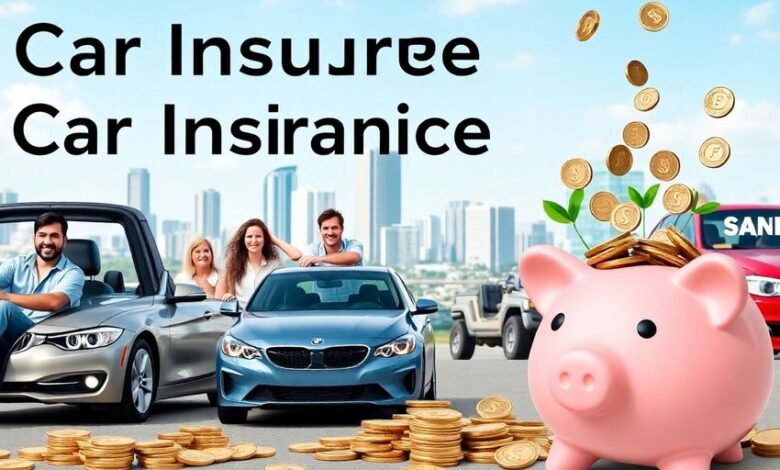
Car insurance can really drain your wallet, especially with prices hiking up over the last few years. In fact, from 2023 to 2025, the average cost of full coverage jumped by a whopping 31%. Yikes! But don’t worry—there are ways to save money on your premiums. Understanding what you can control and making smart choices can help you keep more cash in your pocket. Let’s explore some proven strategies on how to beat car insurance in 2025!
Key Takeaways
- Understand your policy well to avoid unnecessary coverage and costs.
- Look for discounts; they can significantly lower your premium.
- Regularly compare insurance quotes to find the best rates.
- Adjust your coverage based on your needs and driving habits.
- Consider telematics or usage-based insurance for potential savings.
Understanding Your Car Insurance Policy

Key Components of Coverage
Okay, so you’ve got a car, and you know you need insurance, but what does it all mean? It’s more than just a piece of paper. Think of your policy as a safety net, but one you need to understand to use properly. The key is knowing what each part covers.
- Liability coverage is what protects you if you hurt someone else or damage their property. It’s usually split into two numbers, like 50/100/50. The first two are for bodily injury, per person and per accident, and the last is for property damage.
- Collision coverage pays for damage to your car if you hit another vehicle or object, no matter who’s at fault. This usually comes with a deductible.
- Comprehensive coverage covers things like theft, vandalism, weather damage (hail, floods), and hitting a deer. Also has a deductible.
It’s easy to just pay the bill every month and forget about it, but taking the time to understand these components can save you a lot of headaches (and money) down the road.
Common Exclusions to Watch For
Car insurance isn’t a magic shield that protects you from everything. There are definitely things it won’t cover, and it’s important to know what those are.
- Intentional damage: If you deliberately crash your car, don’t expect your insurance to pay up.
- Using your car for commercial purposes without the right coverage: Delivering pizzas or driving for a ride-sharing service usually requires a special policy.
- Damage from wear and tear: Your insurance isn’t going to pay for new tires or brake pads. That’s on you.
It’s also worth noting that some policies have specific exclusions for things like racing or off-roading. Always read the fine print! You might want to check out a car insurance buying guide for more information.
How to Read Your Policy Effectively
Alright, so you’ve got this stack of papers (or a PDF) from your insurance company. It can look intimidating, but breaking it down makes it manageable. Here’s how:
- Start with the declarations page: This is usually the first page and summarizes your coverage, limits, deductibles, and premium. It’s the cheat sheet.
- Read the definitions section: Insurance policies use specific language, so make sure you understand what they mean by terms like “insured,” “accident,” and “vehicle.”
- Pay attention to exclusions: This section lists what your policy doesn’t cover. It’s crucial to know this to avoid surprises later.
It might seem boring, but understanding your policy is like knowing the rules of a game. You can’t win if you don’t know how to play. And if you’re still confused, don’t be afraid to call your insurance agent and ask questions. That’s what they’re there for!
Exploring Discounts and Savings Opportunities

Alright, so you’re looking to save some cash on car insurance, right? One of the easiest ways to do that is by exploring all the discounts and savings opportunities out there. Insurance companies aren’t exactly shouting these from the rooftops, so it’s up to you to dig in and see what you can find. It’s like a treasure hunt, but instead of gold, you get lower premiums. Let’s get started.
Types of Discounts Offered
Okay, so what kind of discounts are we talking about? Well, there’s a whole bunch. You’ve got your standard ones like safe driver discounts, which are pretty self-explanatory – if you haven’t had any accidents or tickets in a while, you’re in luck. Then there are multi-car discounts if you insure more than one vehicle with the same company. Some companies offer discounts for having anti-theft devices installed in your car, or for being a student with good grades. And don’t forget about discounts for being a member of certain organizations or having certain professions. It really varies from company to company, so it pays to ask.
How to Qualify for Discounts
So, you know about the discounts, but how do you actually get them? Well, for some, it’s automatic. Like, if you’ve been driving safely for years, the safe driver discount should just kick in. But for others, you need to be proactive. Call your insurance company and ask about every single discount they offer. See if you qualify for any based on your job, your affiliations, or any safety features your car has. Sometimes, it’s as simple as filling out a form or providing proof of something. Don’t assume you’re getting all the discounts you’re entitled to – double-check!
Maximizing Your Savings Potential
Okay, so you’ve found some discounts, but how do you squeeze every last penny out of them? First, shop around. Different companies offer different discounts, and some are more generous than others. Second, bundle your insurance. If you have both car and home insurance, see if you can get a discount by having them both with the same company. Third, consider increasing your deductible. This means you’ll pay more out-of-pocket if you have an accident, but it can significantly lower your premium. Just make sure you can actually afford that deductible if something happens. Finally, keep your driving record clean. Those tickets and accidents can wipe out any discounts you’re getting, so drive safely!
Getting the best car insurance rate is a continuous process. Don’t just set it and forget it. Review your policy every year, shop around for better rates, and always be on the lookout for new discounts. A little effort can save you a lot of money in the long run.
Shopping Around for Better Rates
When to Compare Quotes
Knowing when to shop around can save you a lot of money. It’s a good idea to compare quotes when your policy is about to renew, especially if your premium has increased significantly. But don’t wait for a renewal to check.
- After a major life event (like moving or getting married).
- If you’ve improved your credit score.
- At least once a year, just to see what’s out there.
Don’t just look at the price. Consider the insurer’s financial stability. A cheap policy isn’t worth it if the company can’t pay claims.
How to Use Online Tools Effectively
Online tools make comparing quotes easier than ever. But it’s important to use them smartly.
- Enter accurate information. Even small errors can affect your quote.
- Compare apples to apples. Make sure you’re getting quotes for the same coverage levels and deductibles.
- Read reviews. See what other customers say about their experiences with different insurers.
Understanding Rate Variations Among Insurers
Why do rates vary so much between insurers? Several factors are at play.
- Risk assessment: Each company has its own way of evaluating risk.
- Overhead costs: Insurers with lower operating expenses may offer lower rates.
- Discounts: Some insurers offer more discounts than others.
Here’s a simplified example of how rates might differ:
| Insurer | Annual Premium | Monthly Payment | Customer Satisfaction (out of 1,000) |
|---|---|---|---|
| Company A | $2,500 | $208.33 | 750 |
| Company B | $2,200 | $183.33 | 700 |
| Company C | $2,800 | $233.33 | 800 |
Adjusting Your Coverage for Savings
It’s easy to just set your car insurance and forget about it, but you could be missing out on some serious savings. Taking a look at your current coverage and making some smart adjustments can really lower your monthly premium. It’s all about finding the right balance between protection and affordability.
Identifying Unnecessary Coverage
Okay, so first things first: what are you actually paying for? A lot of people have coverage they don’t even need. For example, if your car is older and not worth much, collision coverage might not make sense. The cost of the premium and the deductible could end up being more than the car’s worth if you had to make a claim. Think about things like:
- Unused Rental Reimbursement: If you have another car or can easily bum rides, do you really need rental car coverage?
- Overlapping Medical Payments: If you have good health insurance, the medical payments portion of your car insurance might be redundant.
- Outdated Gap Insurance: If you’ve paid off a significant portion of your car loan, you might not need gap insurance anymore.
The Impact of Deductibles on Premiums
Your deductible is the amount you pay out of pocket before your insurance kicks in. Choosing a higher deductible is one of the quickest ways to lower your premium. It’s a trade-off, though. You’ll save money each month, but you’ll have to pay more if you ever have an accident. Here’s a quick example:
| Deductible | Monthly Premium | Potential Savings |
|---|---|---|
| $250 | $150 | – |
| $500 | $125 | $25 |
| $1000 | $100 | $50 |
Just make sure you can actually afford to pay that higher deductible if something happens. Otherwise, you’re just setting yourself up for a headache later.
When to Reassess Your Coverage Needs
Life changes, and so should your insurance. You should reassess your coverage at least once a year, or whenever something significant happens, like:
- Moving to a new neighborhood (rates vary by location).
- Paying off your car loan (you might not need as much coverage).
- Changing your driving habits (less commuting means less risk).
- Adding or removing drivers from your policy.
Reviewing your policy before it renews is a smart move. See if there are additional savings you can get. Also, get some free quotes from other companies to see if switching makes sense.
Utilizing Telematics and Usage-Based Insurance
How Telematics Works
Telematics programs track your driving habits using a device installed in your car or a smartphone app. This device monitors things like speed, acceleration, braking, and mileage. The data is then sent to your insurance company, which uses it to assess your driving risk. It’s like having a driving coach in your car, constantly evaluating your performance. Some programs even offer real-time feedback to help you improve your driving. For example, black box insurance is a type of usage-based program that rewards safe, low-mileage drivers.
Benefits of Usage-Based Policies
Usage-based insurance (UBI) can lead to significant savings, especially if you’re a safe driver. The primary benefit is that your premiums are based on your actual driving behavior, not just demographic factors. This means that if you drive safely and infrequently, you could pay much less than someone with a similar profile who drives more aggressively or frequently.
- Potential for lower premiums
- Personalized feedback on driving habits
- Encourages safer driving
I’ve heard stories of people saving hundreds of dollars a year just by being more mindful of their driving. It’s a win-win: you save money, and you become a safer driver.
Choosing the Right Telematics Program
Not all telematics programs are created equal. Some offer more comprehensive data tracking, while others are simpler. It’s important to research different programs and choose one that fits your needs and driving style. Consider factors like the accuracy of the tracking device, the transparency of the data collection process, and the potential for discounts. Also, make sure you understand how the data will be used and whether it will be shared with third parties. Before switching to another company, compare the discounts and regular prices from multiple insurers. Some companies, like American Family and Travelers, offer substantial discounts for telematics users.
| Insurance Company | Average Annual Premium | Premium with Telematics | Telematics Score (Example) |
|---|---|---|---|
| Example Co. A | $3,000 | $2,000 | 800/1000 |
| Example Co. B | $2,500 | $1,800 | 750/1000 |
Maintaining a Good Driving Record
The Importance of Safe Driving
Okay, so this one might seem super obvious, but seriously, safe driving is a huge deal when it comes to your car insurance rates. The fewer accidents and tickets you have, the lower your premium will be. It’s really that simple. Insurance companies see you as less of a risk if you have a clean driving record, and that translates into savings for you. Think of it this way: every time you speed or cause an accident, you’re basically telling your insurance company that you’re more likely to cost them money in the future. And they’re going to charge you accordingly.
How Accidents Affect Your Premium
Accidents can really mess with your insurance rates. Even a minor fender-bender can cause your premium to go up, and a major accident could send it skyrocketing. The exact impact depends on a bunch of things, like who was at fault, the extent of the damage, and your insurance company’s policies. But here’s a general idea:
- Minor Accident (under $1,000 in damages): Expect a small increase in your premium, maybe 5-15%.
- Moderate Accident ($1,000 – $5,000 in damages): Your premium could jump by 20-40%.
- Major Accident (over $5,000 in damages or involving injuries): You could see your premium increase by 50% or more, and your insurance company might even decide not to renew your policy.
It’s not just about the money, though. Accidents can also lead to points on your license, which can further increase your insurance rates and even lead to a suspension of your driving privileges. So, avoiding accidents is not only good for your wallet, it’s good for your overall driving record.
Tips for Avoiding Traffic Violations
Avoiding traffic violations is key to keeping your insurance rates low. Here are a few tips to help you stay out of trouble:
- Obey Speed Limits: This is the most obvious one, but it’s also the most important. Pay attention to speed limit signs and adjust your speed accordingly.
- Avoid Distractions: Put your phone away, don’t eat or drink while driving, and focus on the road.
- Be Aware of Your Surroundings: Pay attention to other drivers, pedestrians, and cyclists. Anticipate potential hazards and be prepared to react.
- Maintain Your Vehicle: Make sure your car is in good working order. Check your tires, brakes, and lights regularly.
- Drive Defensively: Assume that other drivers are going to make mistakes and be prepared to react accordingly. Leave plenty of space between you and the car in front of you, and always be aware of your surroundings.
Considering Alternative Insurance Options
It’s easy to get stuck in a rut with your car insurance, just renewing the same policy year after year. But in 2025, there are more options than ever before. It’s worth taking a look to see if something else might fit your needs and save you some money.
What is Pay-Per-Mile Insurance?
Pay-per-mile insurance is exactly what it sounds like: you pay based on how much you drive. This can be a fantastic option if you don’t drive much. The way it usually works is you pay a base rate, plus a few cents for each mile you drive. A device tracks your mileage, and you’re billed accordingly. If you work from home, or only use your car for short trips on the weekend, this could save you a bundle. Just make sure to accurately estimate your mileage to avoid any surprises.
Exploring Group Insurance Plans
Did you know that some employers, alumni associations, or other groups offer discounted car insurance? It’s worth checking to see if you’re eligible for any of these group insurance plans. These plans can sometimes offer rates that are lower than what you’d find on your own. The savings come from the insurer getting a large group of customers at once, reducing their marketing and administrative costs. It’s definitely worth a phone call to your HR department or alumni association to see what’s available.
The Rise of Embedded Insurance
Embedded insurance is a relatively new concept, but it’s gaining traction. The idea is that insurance is bundled directly into the purchase of a car or other product. For example, some car manufacturers are starting to offer insurance plans that are integrated with the car’s technology. This can make the process of getting insurance much easier, and it can sometimes offer better rates than traditional insurance. Plus, some of these plans offer unique features, like automatically adjusting your coverage based on how you’re driving. It’s something to keep an eye on as it becomes more common. According to NerdWallet’s 2025 analysis, the most affordable car insurance providers are Geico, Progressive, State Farm, and Travelers.
Don’t be afraid to think outside the box when it comes to car insurance. There are more options than ever before, and it’s worth exploring them to see if you can find a better fit for your needs and budget. You might be surprised at how much you can save by switching to a different type of policy or taking advantage of group discounts.
Final Thoughts on Saving Money on Car Insurance
In the end, saving on car insurance is all about being smart and proactive. You’ve got to shop around, ask questions, and really dig into what each policy offers. Don’t just settle for the first quote you get. Look for discounts, consider bundling your policies, and think about what coverage you actually need. Every little bit helps, especially with rates going up. So, take the time to explore your options and make sure you’re not paying more than you have to. With a little effort, you can find a plan that fits your budget and keeps you protected on the road.
Frequently Asked Questions
What are the main parts of a car insurance policy?
A car insurance policy usually has several important parts, including liability coverage, collision coverage, and comprehensive coverage. Liability helps pay for damages you cause to others, while collision covers damage to your own car. Comprehensive covers non-collision incidents like theft or natural disasters.
How can I find discounts on my car insurance?
Many insurance companies offer discounts for things like being a good driver, having multiple cars, or bundling with other types of insurance. It’s a good idea to ask your insurance agent about available discounts.
When should I shop around for better car insurance rates?
You should compare rates at least once a year or whenever you have a major life change, like moving, buying a new car, or getting married. This way, you can find the best deal possible.
What does it mean to adjust my coverage?
Adjusting your coverage means changing the types or amounts of insurance you have. For example, you might drop coverage that you don’t need anymore or increase your deductible to lower your monthly payment.
What is usage-based insurance?
Usage-based insurance is a type of car insurance where your rates are based on how you drive. If you drive safely and don’t use your car much, you could save money on your premium.
How does my driving record affect my insurance rates?
Your driving record is very important. If you have accidents or traffic violations, your rates may go up. On the other hand, a clean driving record can help you get lower rates.



